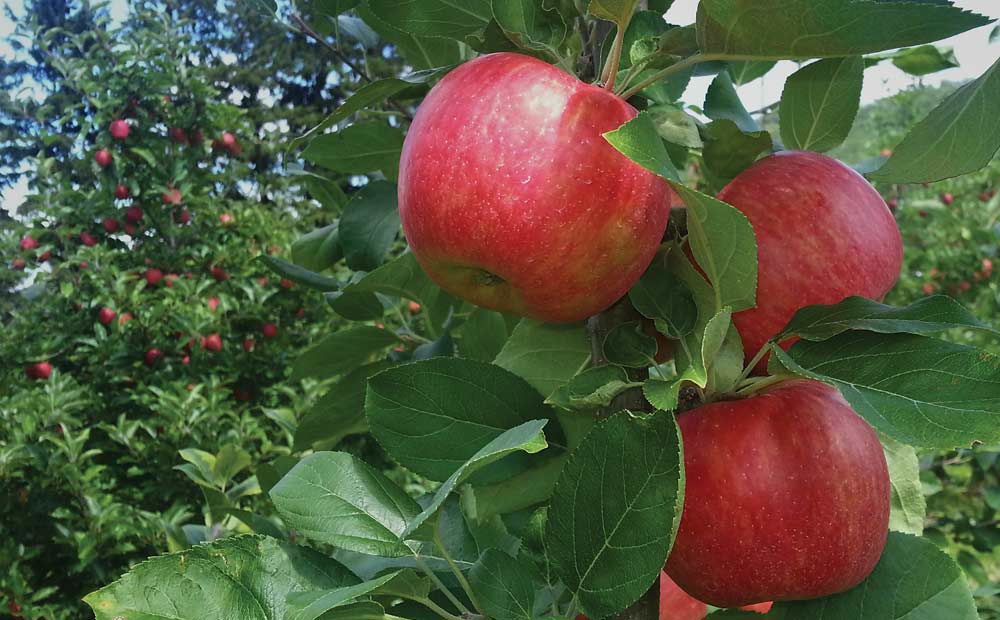
Premier Honeycrisp ripens as much as two to three weeks before regular Honeycrisp. (Courtesy Adams County Nursery)
New varieties aren’t the only things on growers’ minds. They are also thinking about upgrading their Honeycrisp to one of the sports that are all the rage.
“What happens with the great majority of very popular varieties is that a round of red mutations soon follows. That’s what most sports are: mutations that are redder than the original,” said David Bedford, apple breeder and senior research fellow at the University of Minnesota Horticultural Research Center.
As the one of the developers of the original Honeycrisp, he is familiar with some of these newer, shinier models.
A big advantage of a redder Honeycrisp sport is that growers can pick them as soon as they’re ripe and not have to leave them on the tree to color.
That earlier harvesting is better for storage, said Randy Beaudry, Ph.D., a professor at Michigan State University’s Department of Horticulture. “Sometimes we have to wait just a little too long for that color development to take place, so even though I think of Honeycrisp as a bicolor apple, the redder fruits let us get it off the tree in better shape.”
The biggest push behind redder sports, however, is that they command a higher dollar from buyers.
“We’re planting the sport varieties ourselves, because we want to get premium packout, and as growers, we’re getting paid for color,” said Randy Steensma, owner and president of Honey Bear Tree Fruit Company in Wenatchee, Washington. “As the production volume of (high-color) Honeycrisp increases, the bar for color standards of Honeycrisp is just going to get higher and higher.”
Color is indeed driving the apple industry, Bedford agrees, but the race to red is not without pitfalls.
“When you have new mutations starting to show up, they are often some early-coloring versions, but that’s different from early maturing,” he said. “This can be a disadvantage to the variety in the long run if the new sport colors well before it’s mature. If the fruit is picked when it’s red but not ripe, it doesn’t taste the same, and that hurts the variety in the end.”
Some sports actually do mature early, he said. “That seems to be the case from what I’m hearing about Premier Honeycrisp (through Adams County Nursery in Aspers, Pennsylvania), which reportedly ripens as much as two to three weeks before regular Honeycrisp. That’s one of the sports that’s getting a lot of attention.”

Royal Red Honeycrisp is a very popular sport and is known for its brilliant red color. (Photo by Jon Clements, University of Massachusetts Amherst)
Another that is very popular today is Royal Red Honeycrisp (through Willow Drive Nursery in Ephrata, Washington). “That one seems to the most widely planted of the new Honeycrisp sports at the present time. Other new sports being planted include Firestorm and MINNB42.”
Bedford notes, “Most growers have chosen to plant the new red sports because, for the cost of the new tree royalty, they may be able to achieve a 10 to 15 percent better packout in terms of color.” With those kinds of incentives to growers, he said, “It’s getting hard to find anybody who’s just planting standard Honeycrisp anymore.”
Beaudry said that while color is the most readily noticeable of the mutations, others could be useful not only for the marketplace, but also for research purposes.
“Likely there are other mutations out there — sports — that have positive quality attributes like scent, texture and storability that we cannot see,” he said. “There may be some nice science we could do with these nonvisible sports and potentially valuable fruit types sitting right under our noses, but we are unable to find them because they are not visible.”
-by Leslie Mertz, Ph.D., a freelance writer based in Gaylord, Michigan.






is royal red honey crisp a polinater?